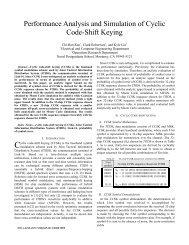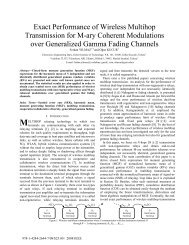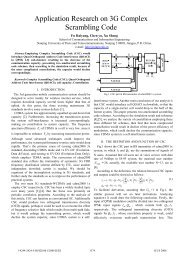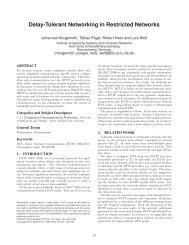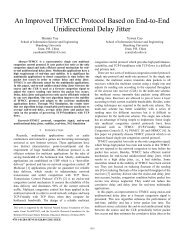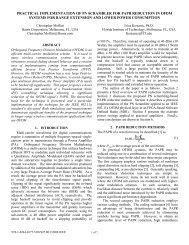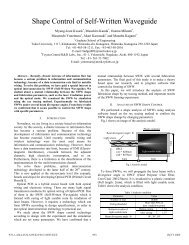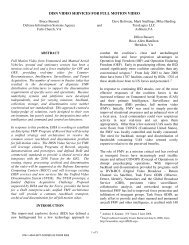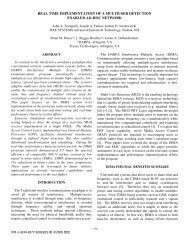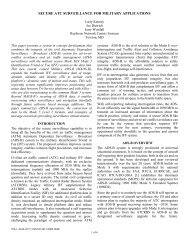2. Research On Streaming Media Online Charging System
2. Research On Streaming Media Online Charging System
2. Research On Streaming Media Online Charging System
You also want an ePaper? Increase the reach of your titles
YUMPU automatically turns print PDFs into web optimized ePapers that Google loves.
A. Summary of data accessing methods<br />
The widely used data accessing methods including Open<br />
Database connectivity (ODBC) method, sharing memory<br />
method [11] and the main memory database method [12], etc.<br />
The introductions to them are as follows.<br />
By ODBC method, data updating and inquiry are realized<br />
by Database Management <strong>System</strong> (DBMS) and the data<br />
needed in applications is accessed from the database through<br />
ODBC. Data management and transaction assurance are<br />
implemented by DBMS, which greatly reduces the difficulty<br />
of application development. Data accessing relies on DBMS<br />
by this method, so the delay of SMOCS’s response to charging<br />
requests will increase and concurrency performance of<br />
SMOCS will be limited by the overall performance of used<br />
database.<br />
By sharing memory method, the data storied in shared<br />
space of main memory is provided for all processes and we<br />
don’t have to save more copies. The relatively stable or readonly<br />
data can be rapidly accessed through shared memory. The<br />
application program does the data updating procedure and<br />
ensures the consistency of the data between shared memory<br />
and database, and thus it increases the difficulty to the<br />
development of application program. By this method we can<br />
access stable data easily, but can’t handle the frequent data<br />
updating procedure effectively in SMOCS.<br />
By main memory database method, almost all data are<br />
stored in main memory to be operated directly. Architecture of<br />
main memory database has been re-designed on the basis of all<br />
data in main memory, and corresponding improvement has<br />
been made in data cache mechanism, fast algorithms, parallel<br />
operations, etc. So the data processing speed of main memory<br />
database is 10 to 100 times that of traditional database. Main<br />
memory database such as TimesTen [13] and eXtremeDB has<br />
been widely used in applications.<br />
B. Performance optimization of <strong>Streaming</strong> <strong>Media</strong> <strong>On</strong>line<br />
<strong>Charging</strong> <strong>System</strong> based on Main Memory Database<br />
Through the analysis of data accessing methods above, we<br />
can greatly improve the efficiency of data accessing. It is<br />
realized by adopting main memory database to manage<br />
customers’ basic information, account balance, accumulated<br />
usage and fees, session information, and billing detail<br />
information in SMOCS. This can greatly improve the speed of<br />
online charging, concurrency and real-time performance of<br />
SMOCS. So a main memory database function (MMDB<br />
Function) module is added to SMOCS’s framework to manage<br />
data information, which not only can reduce the difficulty of<br />
developing SMOCS, but also improve overall performance of<br />
the system. Integrated with main memory database, new<br />
framework of SMOCS is shown in Figure 3.<br />
Making use of main memory database, the new SMOCS<br />
has the following additional advantages:<br />
• Data accessing speed of SMOCS can be improved<br />
greatly due to the storage of account balance, the<br />
accumulated usage and fee, and session information in<br />
main memory;<br />
312<br />
• The main memory database not only improves the<br />
speed of data accessing, but also ensures the data<br />
integrity and reliability by its own copy mechanism<br />
and security strategy;<br />
• For large-scale concurrent charging requests and<br />
shared data accessing, adopting lock mechanism in<br />
main memory database, SMOCS ensures that multithreads/processes<br />
can access critical data safely, and<br />
thus reduces the difficulty of system development.<br />
Figure 3. Framework of SMOCS based on main memory database<br />
IV. EXPERIMENTAL RESULTS<br />
To verify reasonableness of SMOCS’s framework and<br />
performance optimization results of the system, the functions<br />
and performance of the system are tested, with the emphasis<br />
on the average online charging response time. Description of<br />
the test is as follows.<br />
• Oracle9i and Oracle Times Ten In-Memory Database<br />
7.0.5 as database were used respectively. The database<br />
and SMOCS were deployed on two different servers in<br />
the LAN.<br />
• The online charging process of VoD service was<br />
tested. There were 10,000 videos charged by times,<br />
each video was charged differently and every<br />
customer’s ceiling charges are less than��10 within<br />
an account cycle.<br />
• A condition of 100,000 customers sending 100,000<br />
charging requests in all was simulated, and the<br />
customers’ basic information and account balance<br />
were stored in database. The session information and<br />
billing details produced during the online charging<br />
process were saved into database.<br />
• The online charging process was simplified as<br />
initializing a session, accessing customer’s account<br />
balance and accumulated usage, rating, deducting<br />
service fees and generating billing details, the<br />
processing time of online charging was recorded in the<br />
test and the average processing time was computed.<br />
The test includes the following two groups:<br />
• Shared memory scheme. The SMOCS loaded the<br />
customers’ basic information and account balance,<br />
price information of videos and other data at startup,



